No 4 Bus closes in on a century
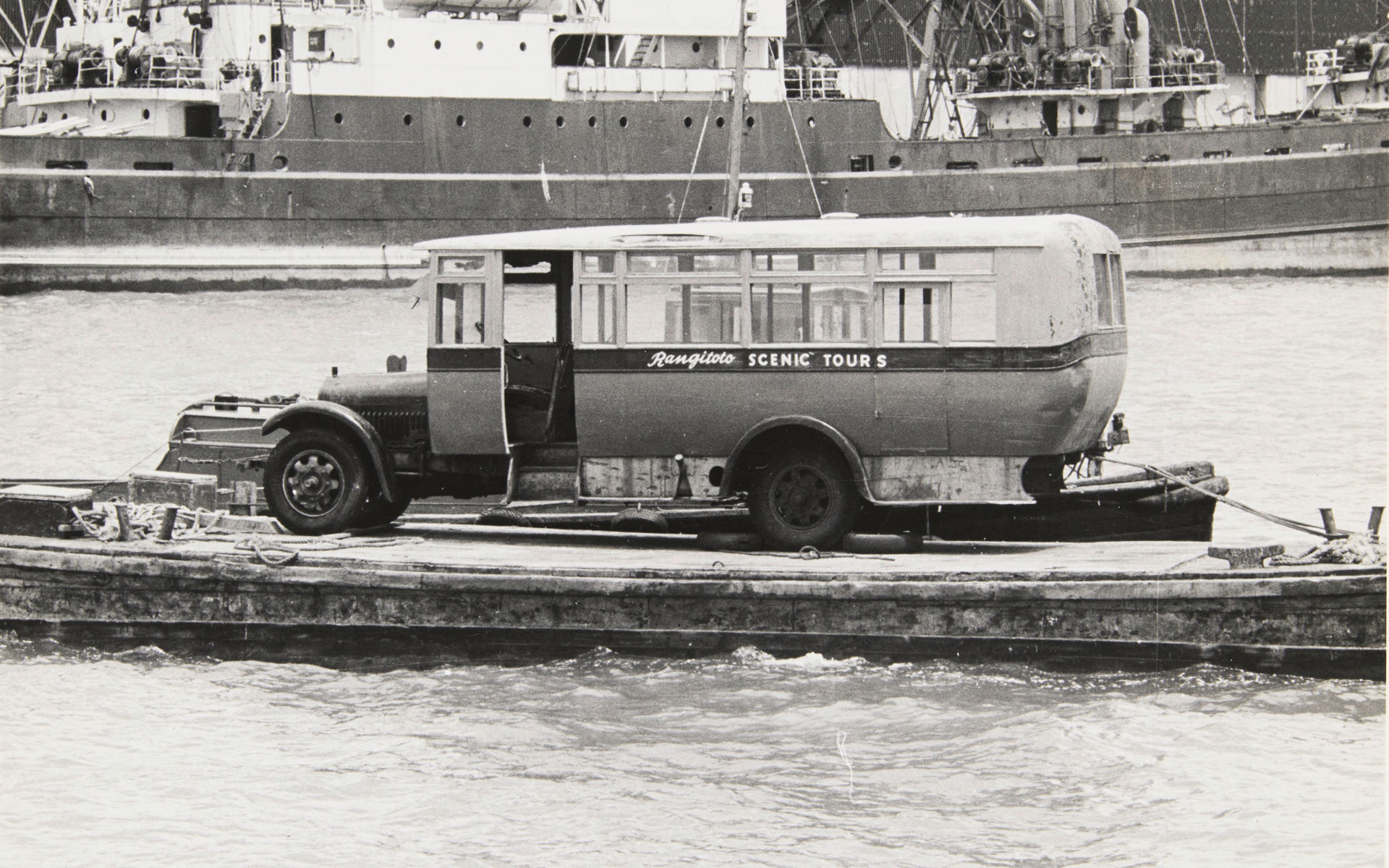
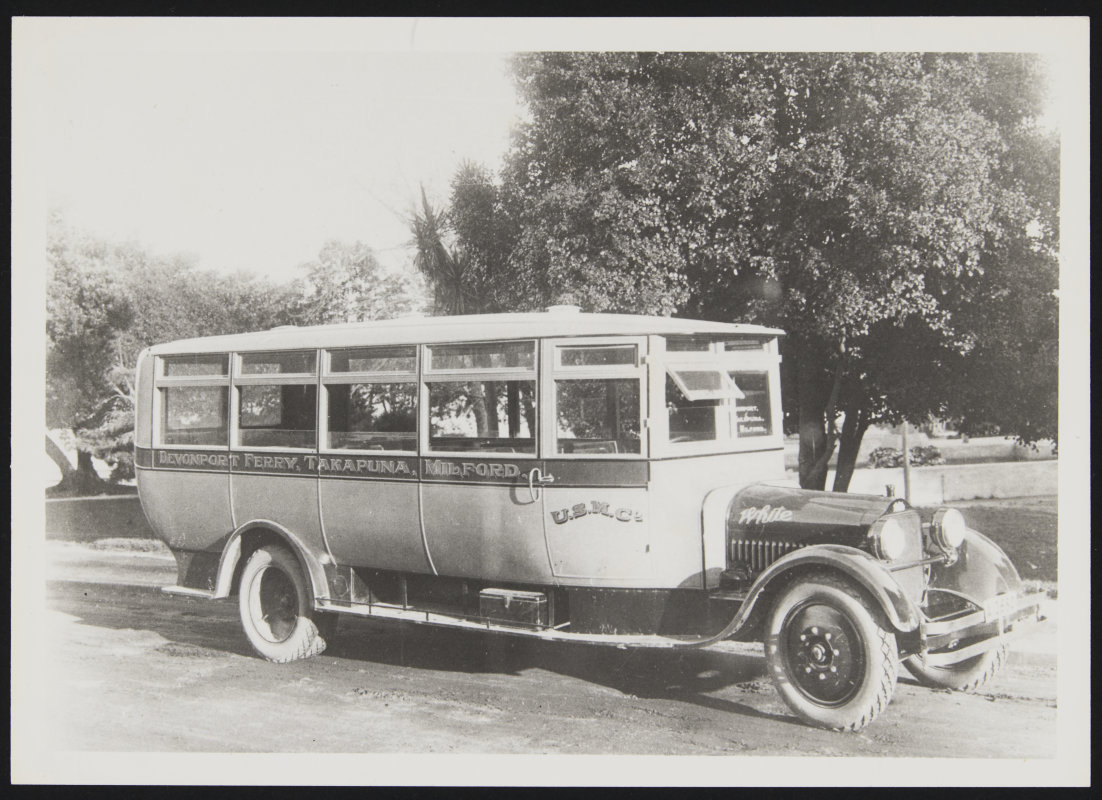
Image: No 4. Unknown photographer. Circa 1920s – 1930s. 05-2245. Walsh Memorial Library, The Museum of Transport and Technology (MOTAT).
This month we take a deep dive into the history of this significant bus, which combines an American chassis with a New Zealand built body.
The White Motor Company (1900 – 1980, also known as the White Motor Car Company) was an automobile, truck, and bus manufacturer based in Cleveland, Ohio. In World War I the company shifted away from automobile production to the design and manufacture of trucks and stayed with this product after the war, eventually becoming the number one maker of trucks and custom vehicles in the United States [1]. This bus, No. 4 when first designated with United Service Motor Bus Company, is an example of the White Motor Company’s left-hand truck chassis built as a passenger vehicle in 1924.
It is believed the bodywork of No. 4 was made by Gilmour, Joll and Williams Limited in New Zealand. This local company was set up in the early 1900s by three partners – Henry Treliving Gilmour, Lewis Joll and Henry Combes Williams. Each of the partners specialised in a particular skillset: Gilmour was the wheelwright and body-maker, Joll the company manager, and Williams the painter and signwriter [2]. The company was a regular at trade shows, such as the Auckland Agricultural Show (in 1909) where they showcased a range of vehicles including a pony trap, long shafted gig and a landau cab [3]. By 1922 Gilmour, Joll and Williams Ltd were advertising as agents for White Trucks and promoted their ability “to turn out big trucks and omnibuses in the shortest possible time [4].”
No. 4 was one of the first buses in the country to have a fully enclosed body, which provided passengers with cover from the weather and a more comfortable journey. There are upholstered seats for 23 passengers, and large windows with openings at the top along the side of the bus. Being an American built chassis, the steering column is on the left-hand of the bus, which is also the side of the bus passengers need to hop on and off from to ensure they avoid colliding with other vehicles using the roads. This led to passengers having to manoeuvre around the driver when entering and exiting the bus.
No. 4 on Auckland’s North Shore
By the mid-1920s, many tramway companies in the country had added buses to supplement their traditional tram fleets and private bus operators also started to emerge. The buses operated feeder services to the tram terminals, allowing for the spreading suburban developments around towns and cities to be serviced. White Motor Company truck chassis were among those modified by the addition of a coach or bus body to transform a truck into a passenger vehicle [5].
Land-powered public transport on the North Shore had been established in 1910 when the Takapuna Tramway and Ferry Company started operating steam trams between Bayswater and Takapuna. This steam tram would link up with the Bayswater ferry. In the early twentieth century, steam ferries were the easiest way to access less densely populated Eastern Bays and before the advent of roads and a bridge connecting the shores of the Waitematā [6].
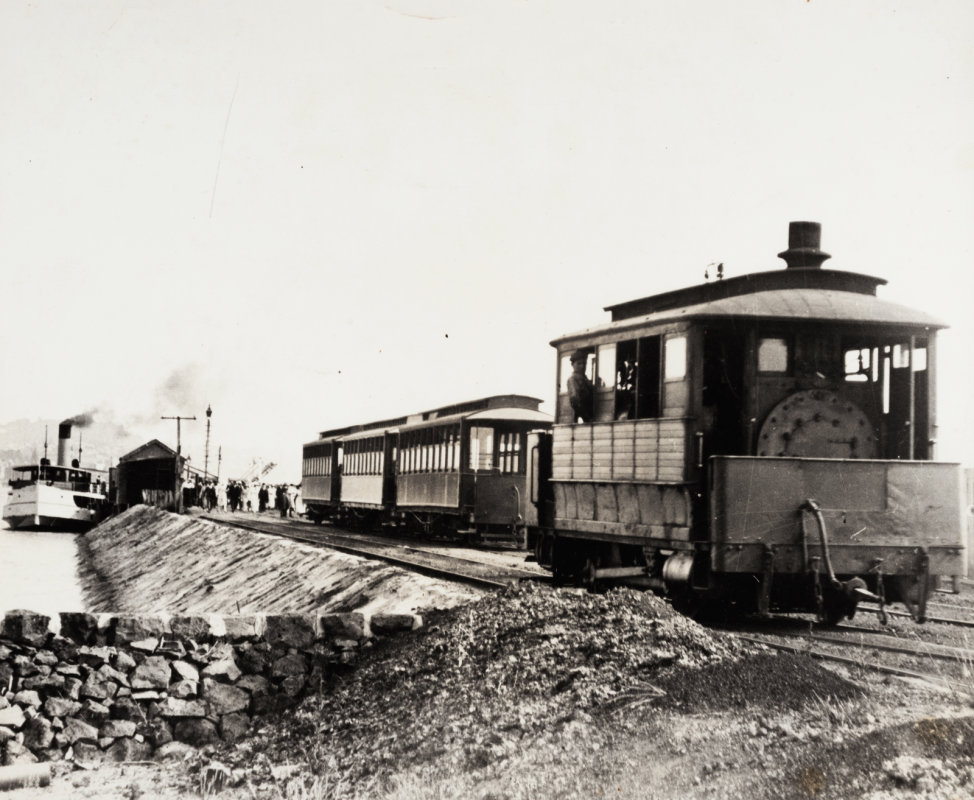
Image: Unknown Photographer. Circa 1910. Steam tram at Bayswater ferry terminal, PHO-2017-4.5. Walsh Memorial Library, The Museum of Transport and Technology (MOTAT).
Throughout the 1910s and 1920s, competition increased for the tramway when private bus operators commenced services accommodated by increasing roading infrastructure. By the 1920s the tramway was also experiencing financial setbacks while the matter of electrification was being discussed [7]. However, competition to the tramway was challenged when unregulated bus operations brought about the 1926 Motor Omnibus Traffic Act which enacted new licensing regulations for private bus operators:

Image: Excerpt from the Act to regulate Motor-omnibus Traffic. Enacted 11th September, 1926.
Takapuna bus operator Alfred Hendry Smith (trading as The United Service Motor Bus Company and first operator of No. 4), challenged the right of Takapuna Borough Council to act as a licensing body, alleging bias to the Takapuna Tramway and Ferry Company [8]. The case was well covered by newspapers of the time and described as “lengthy litigation,” with Smith continuing bus services until Mr. Justice Adams ruled in favour of the Borough Council [9]. After several years of intense change and the growing unpopularity of the tramway, a merge between several smaller land-based operators and the Devonport Steam Ferry Company saw the formation of the North Shore Transport Company (NST) in 1927 [10].
Like the steam tram, NST advertised their buses as a link to ferries and offered services to Takapuna, Milford and “as far as” Browns Bay (1937). By 1940 a timetable shows that NST was operating 18 bus services to Browns Bay from Bayswater between Monday and Friday which linked up with ferries [11].
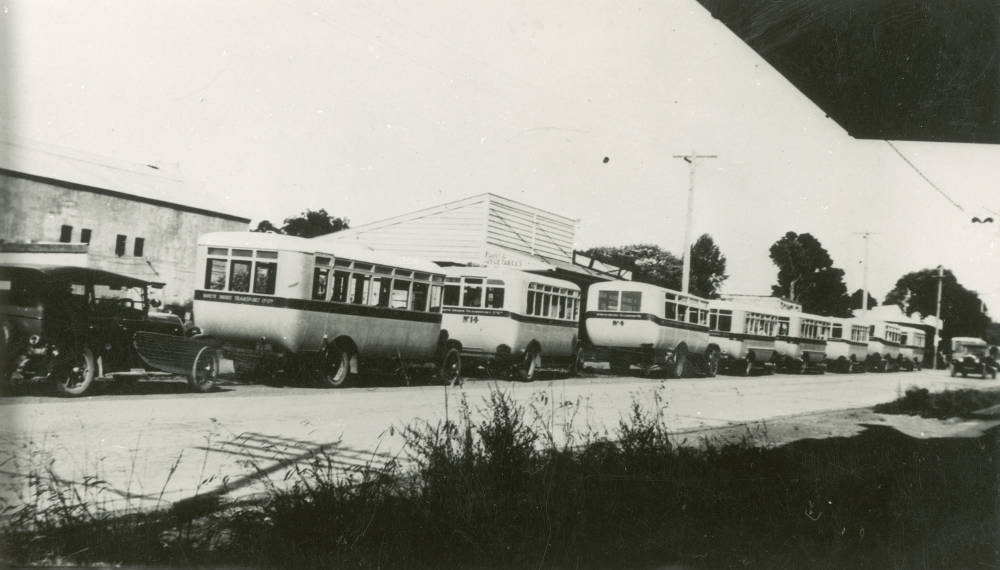
Image: Unknown photographer. Circa 1937-1938 . North Shore Transport Company buses lined up at Milford. No. 4 is the third bus from the left. Auckland Libraries Heritage Collections T0489, No known copyright restrictions.
Bus No. 4 was one of the buses operated by NST. Busses in the NST fleet had a yellow body with a green stripe and the North Shore Transport Company name written in light yellow lettering. By 1928 the NST had a fleet of at least 21 buses [12]. In 1954 NST purchased the Waitematā Bus and Transport Company, expanding its routes towards Wairau and Glenfield roads. An arrangement was made with Birkenhead Transport Limited to operate several of the Northcote routes NST had previously operated [13]. By 1963, NST was operating from a new depot near Wairau Road, and in 1971 it became a part of the Auckland Regional Authority.
A life on Hauraki Gulf’s Islands
While NST was busy growing and changing as Auckland’s public transport came under council control, No. 4 had been reallocated from the North Shore routes. During the late 1930s No. 4 was operating on the islands of the inner Waitematā Harbour, specifically Waiheke and Rangitoto. While operating on Waiheke, buses such as No. 4 connected with the ferries to transport passengers and day trippers around the Island to beaches and then return then passengers back to the wharf. Later No.4 was operated on Rangitoto. Here it was used for scenic tours and bringing visitors up and around the island.

Image: Vehicles on Rangitoto Island. Auckland Libraries Heritage Collections T7614. Bus no. 4 before it was retired and moved to MOTAT in 1965. Unknown photographer. 1937-1938.
Bus no. 4 comes to MOTAT
After several decades of operating, No.4 was retired and moved to MOTAT in 1965. Its final journey started with a barge ride from Rangitoto to downtown Auckland, before being driven to MOTAT. This was done by Subritzky Shipping Line, who were delivering goods to the shop on Rangitoto. The company returned to the city wharf with the bus, and, by coincidence, pilot Fred Ladd was flying overhead in one of Tourist Air Travel’s Grumman Widgeon Amphibians. He made a ‘special dip’ over the barge to commemorate No.4 leaving Rangitoto for the last time [14].
No. 4 arrived at MOTAT in ‘running order’, however the body and interior were in a notably ‘dilapidated’ condition [15]. After five years in the MOTAT collection – but not on display – efforts were made by MOTAT to restore No.4. One factor in the restoration was the upcoming Auckland Centennial celebrations in 1971. MOTAT had been invited by the Auckland City Council to participate in the celebrations with a ‘Pioneer Weekend’ event being proposed. There was a hope that No.4 could be used in a commemorative procession, as well as be operated for visitors to enjoy around MOTAT. Financial and skilled support was requested to the North Shore Transport Company and the Omnibus Proprietors Association [16]. Unfortunately, neither was able to support this cause.
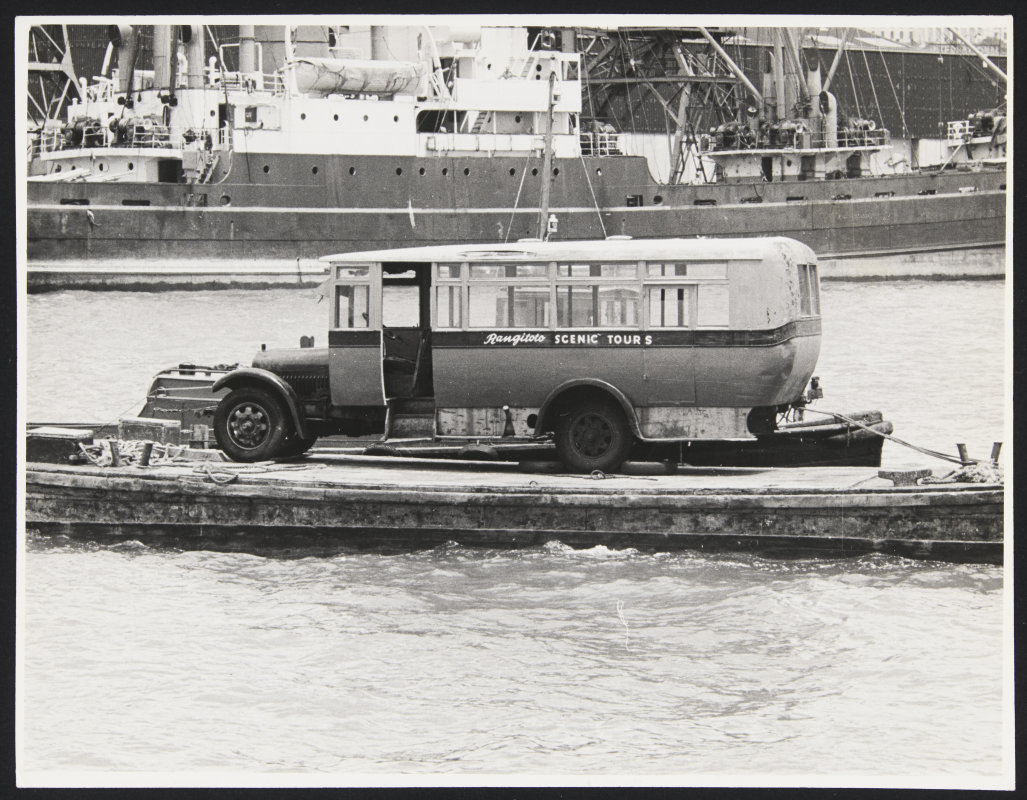
Image: Courtesy of NZ Herald Archive. 1965. White Bus on barge from Rangitoto Island. 05-2247, Walsh Memorial Library, The Museum of Transport and Technology (MOTAT).
It was later that No. 4 was restored by the Museum. The June 1975 issue of MOTAT’s Museum News reported that a group of interested parties resolved to form a Bus Section to manage the museum’s operational fleet, along with the restoration of heritage buses. The group hoped to bring about earlier completion of restoration projects, including the already started restoration of No. 4.
Throughout the next few years, lack of resourcing and weather-proofed storage hampered efforts and, in 1976, bus no. 4’s condition was cited as worse than anticipated [17]. Restoration eventually saw woodwork replaced and the motor ran by volunteers Peter Machin and Doug Findlay [18]. By 1978, with the section still struggling, it was reported that Bill Ritson was making good progress on a rebuild [19]. In 1981 refurbishment was cited as complete and the bus was paraded along Auckland’s city centre streets as part of MOTAT 21st birthday celebrations [20].
Between 2005 and 2006 the bus was once again worked on at MOTAT when the Road Transport Section was assigned responsibility for heritage buses [21]. The Newsletter of the Western Springs Tramway reported bringing it in the workshop and, in February 2006, the bus was running under its own power being driven by Ray Smith after years of being immobile. At present the bus is under covered storage and in stable condition.
As No.4 Bus gets closer to its centenary anniversary, its place in the transport history of Tāmaki Makaurau is an important one and it remains significant as a typical example of a bus in the 1920s. From transporting visitors around the Islands in the Hauraki Gulf to its own ferry trip into Auckland, No. 4 remains a key piece of the public transport history of the region.

The White Bus in its Rangitoto Livery approximately one year after being brought to MOTAT. Stuart Hobbs Collection, reproduced with permission.
Co-authored by Belinda Nevin and Chelsea Renshaw. Published July 2023
References:
Western Reserve Historical Society, White Motor Company records and photographs, MS 5319, http://catalog.wrhs.org/collections/view?docId=ead/MS5319.xml;query=white%20motor%20company;brand=default (accessed 6/12/22)
New Zealand Herald, Volume LV, Issue 16973, 5 October 1918, Page 9 https://paperspast.natlib.govt.nz/newspapers/NZH19181005.2.62?items_per_page=10&page=2&query=Gilmour+Joll+Williams&snippet=true (accessed 5/1/22)
New Zealand Herald, Volume XLVI, Issue 14231, 30 November 1909, Page 7 https://paperspast.natlib.govt.nz/newspapers/NZH19091130.2.98.3?items_per_page=10&page=4&query=Gilmour+Joll+Williams&snippet=true (accessed 5/1/22)
New Zealand Herald, Volume LV, Issue 16973, 5 October 1918, Page 9 https://paperspast.natlib.govt.nz/newspapers/NZH19181005.2.62?items_per_page=10&page=2&query=Gilmour+Joll+Williams&snippet=true (accessed 5/1/22) and Auckland Star, Volume LIII, Issue 156, 4 July 1922, Page 10 https://paperspast.natlib.govt.nz/newspapers/AS19220704.2.127 (accessed 5/1/22)
Auckland Star, Volume LV, Issue 16, 19 January 1924, Page 12 https://paperspast.natlib.govt.nz/newspapers/AS19240119.2.99 (accessed 5/1/22)
Auckland Council, North Shore Heritage Thematic Review Report, 1 July 2011, Page 17 https://www.aucklandcouncil.govt.nz/arts-culture-heritage/heritage/heritagesurveys/north-shore-heritage-thematic-review-volume-1.pdf (accessed 6/12/22)
Auckland Star, Volume LV, Issue 228, 25 September 1924, Page 13 https://paperspast.natlib.govt.nz/newspapers/AS19240925.2.141 (accessed 6/12/22)
Star (Christchurch), Issue 18055, 15 January 1927, Page 10 https://paperspast.natlib.govt.nz/newspapers/TS19270115.2.106 (accessed 6/12/22)
Star (Christchurch), Issue 18028, 13 December 1926, Page 9 https://paperspast.natlib.govt.nz/newspapers/TS19261213.2.142 (accessed 6/12/22)
Auckland Council, North Shore Heritage Thematic Review Report, 1 July 2011, Page 18 and 19 https://www.aucklandcouncil.govt.nz/arts-culture-heritage/heritage/heritagesurveys/north-shore-heritage-thematic-review-volume-1.pdf (accessed 6/12/22)
North Shore Transport Company. 01 Jan 1940. Official Timetable Auckland Brown's Bay Tor Bay, MSS-2018-35. Walsh Memorial Library, The Museum of Transport and Technology (MOTAT). https://collection.motat.nz/objects/108286/official-timetable-auckland-browns-bay-tor-bay (accessed 6/12/22)
North Shore Transport Company's new fleet of buses at Bayswater Wharf, 1929, Takapuna Collection, Auckland Libraries Heritage Collections, T0369 https://kura.aucklandlibraries.govt.nz/digital/collection/photos/id/28408/rec/7 (accessed 6/12/22)
Auckland Council, Auckland Council District Plan (North Shore Section) Proposed Plan Change 38, n.d., Page 3 http://www.aucklandcity.govt.nz/council/documents/districtplannorthshore/changes/2-22verranroadadd11a.pdf (accessed 5/1/22)
Stone, Harold Walton. 1996. The Museum Makers, 01-04. Walsh Memorial Library, The Museum of Transport and Technology (MOTAT).
Letter between MOTAT and North Shore Transport Company. 1970. MOTAT Collection documentation.
Ibid.
MOTAT. October 1975. Museum News. 04-1254. Walsh Memorial Library, The Museum of Transport and Technology (MOTAT) and MOTAT. December 1976. Museum News. 04-1254. Walsh Memorial Library, The Museum of Transport and Technology (MOTAT).
MOTAT. December 1976. Museum News. 04-1254. Walsh Memorial Library, The Museum of Transport and Technology (MOTAT).
MOTAT. March 1978. Museum News. 04-1254. Walsh Memorial Library, The Museum of Transport and Technology (MOTAT).
MOTAT. September 1981. Museum News. 04-1254. Walsh Memorial Library, The Museum of Transport and Technology (MOTAT).
The Western Springs Tramway. November 2005. The Controller. 03-2758. Walsh Memorial Library, The Museum of Transport and Technology (MOTAT).
For other information on White Motor Company and their busses, see here: Jay Leno’s Garage. 2022. Yellowstone Tour Bus: 1936 White Model 706. Accessed 24 April 2023: https://www.youtube.com/watch?v=dbw3Rkl3AAc
Case Western Reserve University. (n.d.) White Motor Corporation. Accessed 24 April 2023: https://case.edu/ech/articles/w/white-motor-corp